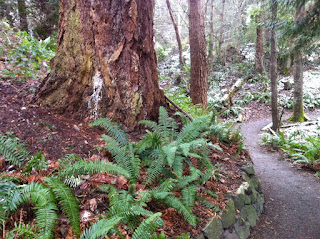Humans are symbiotic with the biosphere to some extent, whether or not we choose to be. We breathe out carbon that trees need, and we consume oxygen that would poison the world if too concentrated. Beyond a few functions like that, humans are parasitic on the biosphere, even though we have the capacity to be symbiotic in all our functions. We consume the Earth's resources to the detriment of the Earth, and often to our own detriment as well. Our current economy relies on conspicuous consumerism, no matter how bad it is for us or the planet.
Members of a symbiotic relationship do not perform their functions for altruistic reasons. They do what they do for their own benefit, to become something more than what they could be alone. The forest of Eagle Landing Park is made possible by micorrhyzae in the soil. Invisible to us, this fungus in the ground allows trees to become big and strong, and grow much faster than they would without this fungal association. Fungi, often the main body of the organism that we see as mushooms, wrap around the tiniest branches of tree roots, coating them. The fungi provide better water and mineral absorption for the trees by being more efficient at interfacing with the soil. The fungi has a larger surface area, and it releases chemicals to allow the transfer of minerals. The trees, in turn, provide sugars to the fungi, for food.
All of the trees in Eagle Landing Park are connected underground by their roots and by the fungi that form this symbiotic relationship with them. Trees can exchange sugars, carbon, and minerals with each other by way of these micorrhyzal fungi. This may be the only thing keeping some trees alive. At the top of the park, near the beginning of the trail, a retaining wall was cut into the soil near a giant Douglas-fir. This excavation occurred in the well-known critical root zone. (The critical root zone is well known in the sense that anybody doing construction or landscaping would know about this, and if you don't know about the critical root zone, you should not be allowed within ten feet of a tree. According to the formula, they should not have done any excavation within 48 feet of that tree.) You could not get a permit to damage a significant tree on your own property with a retaining wall like this. Indeed, the plans provided for construction did not place the wall there. No one seems to know why the workers chose that spot for the retaining wall. They undoubtedly severed and damaged many main, vital roots for this giant tree. It may still succumb to the damage, as some trees take ten years to die after the fatal wound. However, it may survive because there is another large Douglas-fir about twenty feet uphill of this tree. Their roots must grow near each other, and this micorrhyzal association allows them to exchange nutrients, sugars, minerals, and water. Their roots interlock, providing stability. The two trees grow as a unit. One gets more light and the other can harvest more moisture. One trades sugars with the other, for moisture and support. Because of the symbiotic micorrhyzae, the trees are able to help each other survive. Throughout the park, you can see examples of trees of a species growing in groups of two or three, helping each other grow faster and better because of their root networks. Yes, they grow there because that's where the seeds fell, but they survived and flourished because of their connected roots and the micorrhyzae hidden in the soil.
Stone #16 is pictured above, front and center, with another interesting stone and two crab shells. The crab shell above is covered in barnacles, in what appears to be a mutualistic relationship. The barnacles get transportation to new waters for feeding, and the crab gets camouflage, looking like a rock with barnacles on it.
I saw a currant blooming today. A bad picture because all I had was my iPhone and my hands were shaking with the cold. (The currant is probably a cultivar and not a true native. It was planted when the park was built, and did not grow from local seeds.) The dogs and I walked 4 miles, to the beach, to the library, and back. 43 total miles.



No comments:
Post a Comment